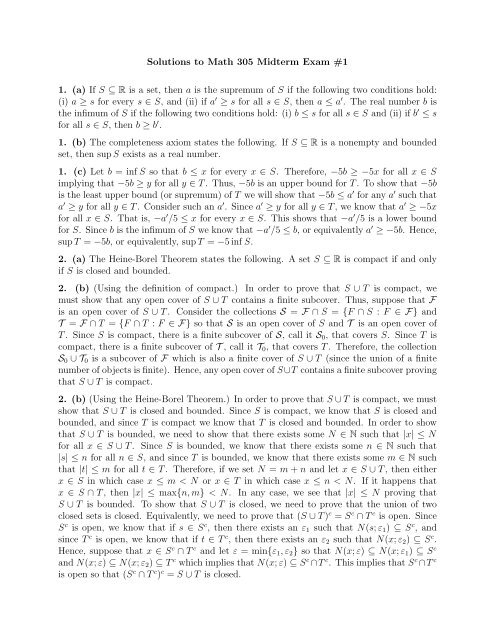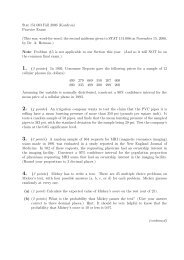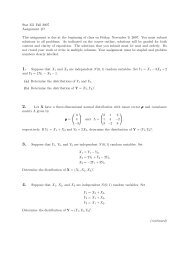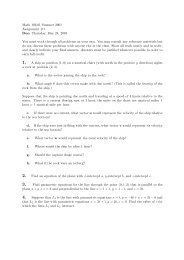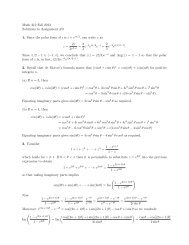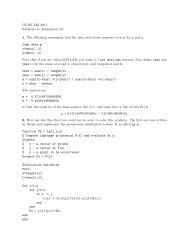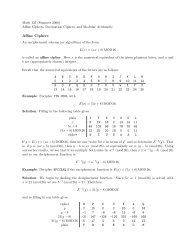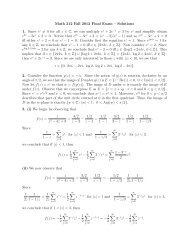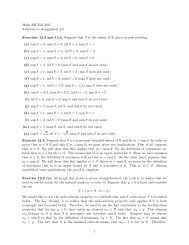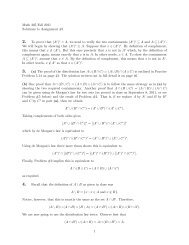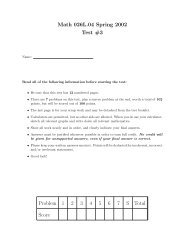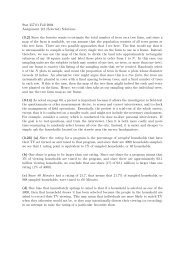Solutions to Math 305 Midterm Exam #1 1. (a) If S â R is a set, then ...
Solutions to Math 305 Midterm Exam #1 1. (a) If S â R is a set, then ...
Solutions to Math 305 Midterm Exam #1 1. (a) If S â R is a set, then ...
You also want an ePaper? Increase the reach of your titles
YUMPU automatically turns print PDFs into web optimized ePapers that Google loves.
<strong>Solutions</strong> <strong>to</strong> <strong>Math</strong> <strong>305</strong> <strong>Midterm</strong> <strong>Exam</strong> <strong>#1</strong><strong>1.</strong> (a) <strong>If</strong> S ⊆ R <strong>is</strong> a <strong>set</strong>, <strong>then</strong> a <strong>is</strong> the supremum of S if the following two conditions hold:(i) a ≥ s for every s ∈ S, and (ii) if a ′ ≥ s for all s ∈ S, <strong>then</strong> a ≤ a ′ . The real number b <strong>is</strong>the infimum of S if the following two conditions hold: (i) b ≤ s for all s ∈ S and (ii) if b ′ ≤ sfor all s ∈ S, <strong>then</strong> b ≥ b ′ .<strong>1.</strong> (b) The completeness axiom states the following. <strong>If</strong> S ⊆ R <strong>is</strong> a nonempty and bounded<strong>set</strong>, <strong>then</strong> sup S ex<strong>is</strong>ts as a real number.<strong>1.</strong> (c) Let b = inf S so that b ≤ x for every x ∈ S. Therefore, −5b ≥ −5x for all x ∈ Simplying that −5b ≥ y for all y ∈ T . Thus, −5b <strong>is</strong> an upper bound for T . To show that −5b<strong>is</strong> the least upper bound (or supremum) of T we will show that −5b ≤ a ′ for any a ′ such thata ′ ≥ y for all y ∈ T . Consider such an a ′ . Since a ′ ≥ y for all y ∈ T , we know that a ′ ≥ −5xfor all x ∈ S. That <strong>is</strong>, −a ′ /5 ≤ x for every x ∈ S. Th<strong>is</strong> shows that −a ′ /5 <strong>is</strong> a lower boundfor S. Since b <strong>is</strong> the infimum of S we know that −a ′ /5 ≤ b, or equivalently a ′ ≥ −5b. Hence,sup T = −5b, or equivalently, sup T = −5 inf S.2. (a) The Heine-Borel Theorem states the following. A <strong>set</strong> S ⊆ R <strong>is</strong> compact if and onlyif S <strong>is</strong> closed and bounded.2. (b) (Using the definition of compact.) In order <strong>to</strong> prove that S ∪ T <strong>is</strong> compact, wemust show that any open cover of S ∪ T contains a finite subcover. Thus, suppose that F<strong>is</strong> an open cover of S ∪ T . Consider the collections S = F ∩ S = {F ∩ S : F ∈ F} andT = F ∩ T = {F ∩ T : F ∈ F} so that S <strong>is</strong> an open cover of S and T <strong>is</strong> an open cover ofT . Since S <strong>is</strong> compact, there <strong>is</strong> a finite subcover of S, call it S 0 , that covers S. Since T <strong>is</strong>compact, there <strong>is</strong> a finite subcover of T , call it T 0 , that covers T . Therefore, the collectionS 0 ∪ T 0 <strong>is</strong> a subcover of F which <strong>is</strong> also a finite cover of S ∪ T (since the union of a finitenumber of objects <strong>is</strong> finite). Hence, any open cover of S ∪T contains a finite subcover provingthat S ∪ T <strong>is</strong> compact.2. (b) (Using the Heine-Borel Theorem.) In order <strong>to</strong> prove that S ∪ T <strong>is</strong> compact, we mustshow that S ∪ T <strong>is</strong> closed and bounded. Since S <strong>is</strong> compact, we know that S <strong>is</strong> closed andbounded, and since T <strong>is</strong> compact we know that T <strong>is</strong> closed and bounded. In order <strong>to</strong> showthat S ∪ T <strong>is</strong> bounded, we need <strong>to</strong> show that there ex<strong>is</strong>ts some N ∈ N such that |x| ≤ Nfor all x ∈ S ∪ T . Since S <strong>is</strong> bounded, we know that there ex<strong>is</strong>ts some n ∈ N such that|s| ≤ n for all n ∈ S, and since T <strong>is</strong> bounded, we know that there ex<strong>is</strong>ts some m ∈ N suchthat |t| ≤ m for all t ∈ T . Therefore, if we <strong>set</strong> N = m + n and let x ∈ S ∪ T , <strong>then</strong> eitherx ∈ S in which case x ≤ m < N or x ∈ T in which case x ≤ n < N. <strong>If</strong> it happens thatx ∈ S ∩ T , <strong>then</strong> |x| ≤ max{n, m} < N. In any case, we see that |x| ≤ N proving thatS ∪ T <strong>is</strong> bounded. To show that S ∪ T <strong>is</strong> closed, we need <strong>to</strong> prove that the union of twoclosed <strong>set</strong>s <strong>is</strong> closed. Equivalently, we need <strong>to</strong> prove that (S ∪ T ) c = S c ∩ T c <strong>is</strong> open. SinceS c <strong>is</strong> open, we know that if s ∈ S c , <strong>then</strong> there ex<strong>is</strong>ts an ε 1 such that N(s; ε 1 ) ⊆ S c , andsince T c <strong>is</strong> open, we know that if t ∈ T c , <strong>then</strong> there ex<strong>is</strong>ts an ε 2 such that N(x; ε 2 ) ⊆ S c .Hence, suppose that x ∈ S c ∩ T c and let ε = min{ε 1 , ε 2 } so that N(x; ε) ⊆ N(x; ε 1 ) ⊆ S cand N(x; ε) ⊆ N(x; ε 2 ) ⊆ T c which implies that N(x; ε) ⊆ S c ∩T c . Th<strong>is</strong> implies that S c ∩T c<strong>is</strong> open so that (S c ∩ T c ) c = S ∪ T <strong>is</strong> closed.
3. (a) To show that f <strong>is</strong> not bijective, it <strong>is</strong> sufficient <strong>to</strong> show that there ex<strong>is</strong>t pointsx 1 ∈ [−2, 2] and x 2 ∈ [−2, 2] with x 1 ≠ x 2 such that f(x 1 ) = f(x 2 ). <strong>If</strong> we take x 1 = −1 andx 2 = 1, <strong>then</strong> x 1 ≠ x 2 but f(x 1 ) = f(x 2 ) = <strong>1.</strong> Hence, f <strong>is</strong> not bijective.3. (b) To show that f −1 (S) <strong>is</strong> an open <strong>set</strong>, it <strong>is</strong> sufficient <strong>to</strong> show that if x ∈ f −1 (S),<strong>then</strong> there ex<strong>is</strong>ts some ε > 0 such that N(x; ε) ⊆ f −1 (S). Therefore, let x ∈ f −1 (S)so that x 2 ∈ S. Consider N(x; ε) = (x − ε, x + ε). Since f(x) = x 2 , we know thatf(N(x; ε)) = f((x − ε, x + ε)) = ((x − ε) 2 , (x + ε) 2 ). Since x 2 ∈ S and S <strong>is</strong> open weknow that there ex<strong>is</strong>ts some ε 1 > 0 such that N(x 2 ; ε 1 ) = (x 2 − ε 1 , x 2 + ε 1 ) ⊆ S. Hence, theproof will be completed if we can choose ε such that ((x − ε) 2 , (x + ε) 2 ) ⊆ x 2 + ε 1 . Observethat (x + ε) 2 = x 2 + 2xε + ε 2 and so we choose ε such that 2xε + ε 2 < ε 1 .3. (c) Observe that f −1 (T c ) = {x ∈ [−2, 2] : f(x) ∈ T c } = {x ∈ [−2, 2] : f(x) /∈ T }.However, the <strong>set</strong> of x ∈ [−2, 2] such that f(x) /∈ T <strong>is</strong>, by definition, the complement of the<strong>set</strong> of x ∈ [−2, 2] such that f(x) ∈ T . Therefore, we findf −1 (T c ) = {x ∈ [−2, 2] : f(x) /∈ T } = {x ∈ [−2, 2] : f(x) ∈ T } c = [f −1 (T )] cas required.4. We claim thatbd S ={0, 1, 1 2 , 1 3 , 1 } { } 14 , . . . =n : n ∈ N ∪ {0}.Suppose first that x = 0 and let ε > 0 be arbitrary. The Archimedean property implies thatthere ex<strong>is</strong>ts some m ∈ N such that 0 < 1/m < ε. Moreover, since R <strong>is</strong> complete, we knowthat there ex<strong>is</strong>ts some y ∈ R such that 0 < 1/(m + 1) < y < 1/m < ε. Thus, y ∈ S andy ∈ N(0; ε) so that N(x; ε) ∩ S ≠ ∅. Since 0 /∈ S we conclude that N(0; ε) ∩ S c ≠ ∅ sothat 0 ∈ bd S. Now assume that x = 1/n for some n ∈ N and let ε > 0 be arbitrary. Since1/n /∈ S we conclude that N(1/n; ε) ∩ S c ≠ ∅. Since R <strong>is</strong> complete, we know that if thereex<strong>is</strong>ts some irrational y withy ∈{x ∈ R : 1 n − ε < x < 1 } [ 1n + ε =n − ε, 1 ]n + εfor every ε > 0. Thus, y ∈ S and y ∈ N(1/n; ε) so that N(1/n; ε) ∩ S ≠ ∅ for every ε > 0.Hence, we have shown that { 1n : n ∈ N }∪ {0} ⊆ bd S.To show the reverse containment, suppose that x ∈ (0, 1) with x ≠ 1/n for some n ∈ N. TheArchimedean property implies that there ex<strong>is</strong>ts some m ∈ N such that 1/(m+1) < x < 1/m.<strong>If</strong> we <strong>set</strong>ε = 1 ( 12 m − 1 )1=m + 1 2m(m + 1) ,<strong>then</strong>N(x; ε) ∩{0, 1, 1 2 , 1 3 , 1 }4 , . . . = ∅.2
Thus, x /∈ bd S. <strong>If</strong> x < 0, let ε = −x/2 so that N(x; ε) ∩ (0, 1) = ∅ so that x /∈ bd S. <strong>If</strong>x > 1, let ε = (x − 1)/2 so that N(x; ε) ∩ (0, 1) = ∅ so that x /∈ bd S. Thus we have shownthat{ } 1bd S =n : n ∈ N ∪ {0}.5. We claim that bd S = [0, 1]. Suppose that{1y ∈ x ∈ R :n + 1 ≤ x ≤ 1 }n=[ 1n + 1 , 1 ].nFor any ε > 0, we know that N(y; ε) contains irrational numbers so that N(y; ε)∩(R\S) ≠ ∅.But we know that N(y; ε) also contains some r ∈ Q such that 1/(n + 1) < r < 1/n. Thus,[ 1n + 1 , 1 ]⊆ bd Snfor every n ∈ N. Observe 0 /∈ S so that we cannot immediately conclude that N(0; ε)∩S ≠ ∅.However, we knows that if ε > 0, <strong>then</strong> there ex<strong>is</strong>ts some n such that 0 < 1/n < ε whichimplies that[ 1N(0; ε) ∩n + 1 , 1 ]≠ ∅.nThus, N(0; ε) ∩ S ≠ ∅ so that 0 ∈ bd S. Since we can write[0, 1] = {0} ∪ ⋃ [ 1n + 1 , 1 ],nn∈Nwe conclude that [0, 1] ⊆ bd S. To show that [0, 1] = bd S, suppose that y /∈ [0, 1] so thateither y < 0 or y > <strong>1.</strong> <strong>If</strong> y < 0, let ε = −y/2 so that N(y; ε) ∩ [0, 1] = ∅ so that y /∈ bd S.<strong>If</strong> y > 1, let ε = (y − 1)/2 so that N(y; ε) ∩ [0, 1] = ∅ so that y /∈ bd S. Thus, if y /∈ [0, 1],<strong>then</strong> y /∈ bd S. Th<strong>is</strong> implies that bd S = [0, 1].6. We claim that S ′ = {−1/2, 1/2} so that cl S = S ∪ S ′ . Observe that{ } { n12n + 1 : n ∈ N =3 , 2 5 , 3 7 , 4 }9 , . . .so that the terms get arbitrarily close <strong>to</strong> 1/2. Therefore,{}(−1) n n2n + 1 : n ∈ N ={− 1 3 , 2 5 , −3 7 , 4 }9 , . . . ={− 1 }3 , −3 7 , . . . ∪The terms in {− 1 3 , −3 7 , . . . }{ 25 , 4 9 , . . . }.get arbitrarily close <strong>to</strong> −1/2 while the terms in{ 25 , 4 9 , . . . }3
get arbitrarily close <strong>to</strong> 1/2. Hence, we find S ′ = {−1/2, 1/2}. To prove that th<strong>is</strong> <strong>is</strong> indeedS ′ , we know from the Archimedean property that for every ε > 0 there ex<strong>is</strong>ts an n such that12 − ε < n2n + 1 < 1 2 and − 1 2 < − n2n + 1 < −1 2 + ε.Th<strong>is</strong> means that for every ε > 0 we have N ∗ (1/2, ε)∩S ≠ ∅ and N ∗ (−1/2, ε)∩S ≠ ∅ implyingthat {−1/2, 1/2} ⊆ S. On the other hand, if x > 1/2 or x < −1/2 and ε = (|x| − 1/2)/2,<strong>then</strong> N ∗ (1/2, ε) ∩ S = ∅ and N ∗ (−1/2, ε) ∩ S = ∅. Similarly, if −1/3 < x < 2/5 andε = max{|2/5 − x|, | − 1/3 − x|}/2, <strong>then</strong> N ∗ (x, ε) ∩ S = ∅. Finally, if 2/5 ≤ x < 1/2, <strong>then</strong>by the Archimedean property, there ex<strong>is</strong>ts an n such thatn2n + 1 < x < n + 22(n + 2) + 1 ,while if −1/2 < x < −1/3, <strong>then</strong> by the Archimedean property, there ex<strong>is</strong>ts an n such thatTh<strong>is</strong> implies that S ′ = {−1/2, 1/2}.n + 2−2(n + 2) + 1 < x < − n2n + 1 .4


